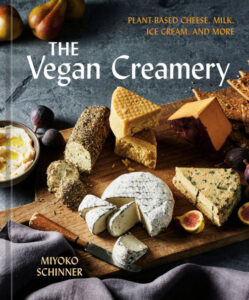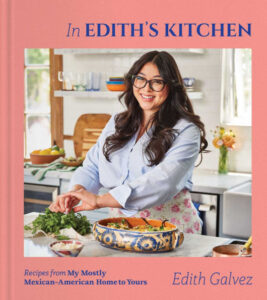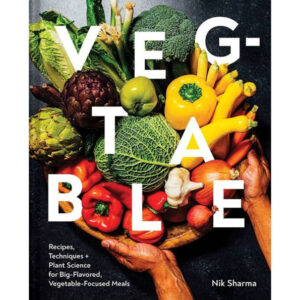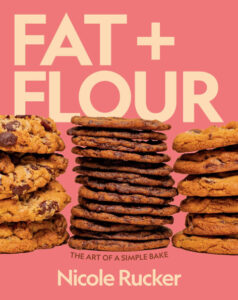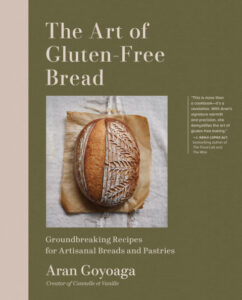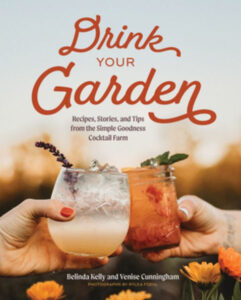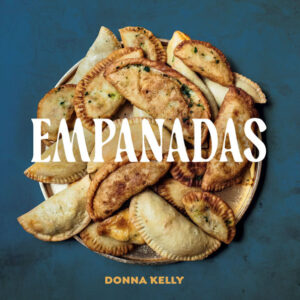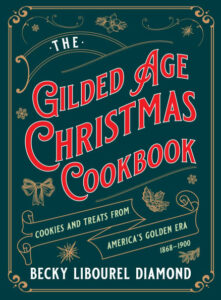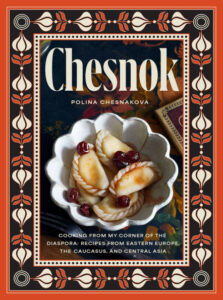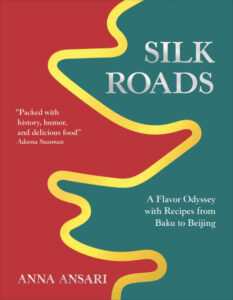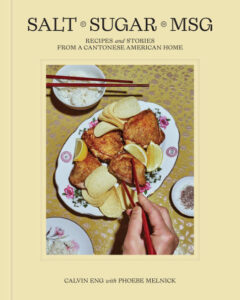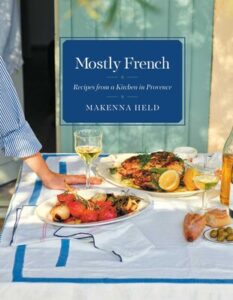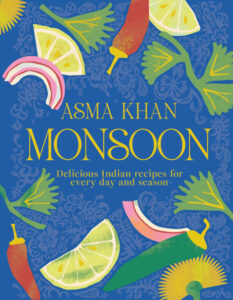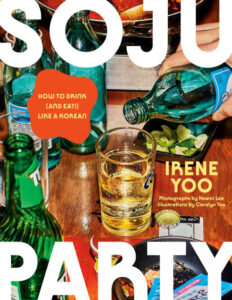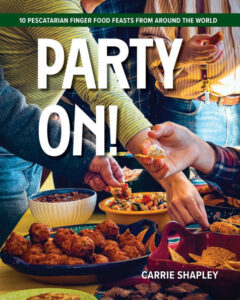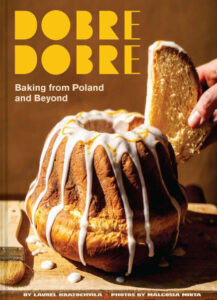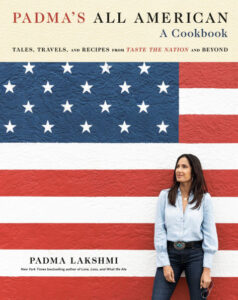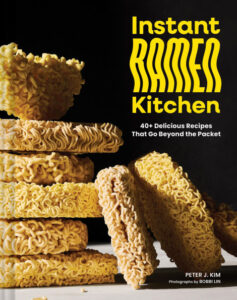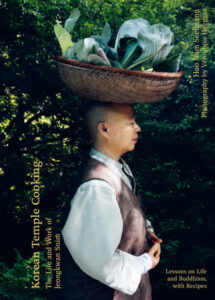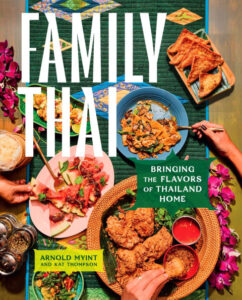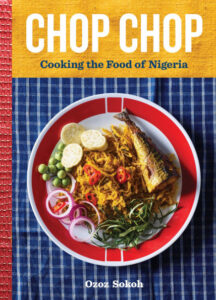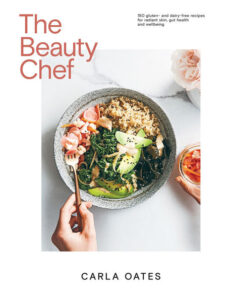As I researched the 25 cookbooks included here, a singular theme arose: Food as touchstone to bring together generations across culture, geography and dislocation. Food as shared heritage, no matter your background. Food as identity. I live – as I am sure you do – in a country of immigrants. My parents are immigrants. I am a third culture kid. We each search for our own identity, our own meaning amidst the chaos and carnage that is the world today. Food is solace. Life is full of heartbreak but in food, especially food shared around a communal table, there is joy in every dish.
I’ve chosen just a few of the thousands of cookbooks released this calendar year that inspire me. Each is a journey, a trip that tantalizes your taste buds and your intellect.
During the quieter season of winter, my wish is that you choose one or two to guide your senses and your kitchen spirit. Through cooking, my hope for you and for the greater community, is to find joy in something truly delicious, a dish that speaks to your heart and soul. And that you find the open-heartedness within to share it with others.
Here’s to cooking!
Cookbooks written by California Authors
The Vegan Creamery
By Miyoko Schinner
Miyoko Schinner launched a revolution when she began fiddling with plant-based milks. Her plant-based butter sold under her eponymously-named brand, Miyoko’s, is an able replacement for cow’s milk butter. Though the Sonoma-based chef no longer owns the company, she remains a passionate advocate, teacher and guide to working with plant-based alternatives.
Filled with recipes for making your own plant-based milk, cheese, ice cream and her famous butter, the cookbook is an explainer for making each of these vegan goodies yourself. Things can get a little nerdy – sourcing vegan dairy culture, calcium sulfate, and refined shea butter are part of the fun of making some of the yogurts and cheeses. Gluten-free Salted Hazelnut Brownies in the No Waste Chapter, utilizes the leftover pulp from making Hazelnut Milk from In the Land of Milk and Cream chapter. If only we could all live this way.
Obvs, this book is for passionate vegans and homesteaders but also your friend who cannot tolerate dairy and saves compost scraps for their garden.
In Edith’s Kitchen
By Edith Galvez
I had no idea what ASMR videos were until I learned about vlogger Edith Galvez. ASMR, or Autonomous Sensory Meridian Response, is said to be a sensation of tingling in the head and neck triggered by audio-visual stimuli. It is supposed to help with insomnia, anxiety and other disorders. Galvez’s videos involve no speaking – just watch her cook Mexican-American food and be calmed.
Galvez, who lives in LA, kicks off her book with Desayuno, or breakfast. Conchas, riding a wave of popularity in California, are here, as are banana pancakes and huevos rancheros. There is plenty of space for traditional Mexican dishes like Sopa de Fideo, Mole Con Pollo and Sweet and Spicy Pork Skins but ample room is given to crossover fare like Loaded Carne Asada Nachos, Ham & Cheese Spaghetti, and Lemon Blueberry Loaf Cake.
I love the crossover Cal-Mex recipes here – I’d never heard of Tostilocos before, a sort-of Chex Mix made with Tostitos, peanuts, chamoy and diced jicama – but now I can’t stop thinking about it!
Veg-Table
By Nik Sharma
Widely known for his recipe-focused blog, A Brown Table, Nik Sharma perhaps needs no introduction as a food nerd. A trained molecular biologist, Sharma presents plant science as a natural part of a cookbook. Discussing each organism’s unique characteristics is part of the package. Pair this with casual style and you have the essence of why he is an awarded author – people get it. His latest cookbook is much the same, but this time, Sharma writes the recipes in a running style – there is no list of ingredients at the start. I find this helpful mid-recipe but more challenging while building a shopping list.
Never mind that. The not entirely vegetarian recipes here (Gochujang Chicken makes an appearance next to Sesame Sweet Potatoes and is a central player in Chayote Chicken Soup while steak appears as Garlic Miso Steak) place veg at the center of the table. Recipes are organized by family – Chapter One’s Onions, Shallots, Leeks, Garlic + Chives gives way to Chapter 3’s Bamboo + Corn and Chapter 12’s Okra, for example. Each chapter leads with plant family history and info (the Nightshade intro spans two pages) and each recipe has a picture alongside.
The veg-forward approach feels natural for Sharma. He spent years in the San Francisco Bay Area before decamping to LA, an even more vegcentric part of California. Sharma’s books are dense reads with food as science and delight. Got a burgeoning science nerd in your house? Or a full-fledged one? This book is for them.
Fat & Flour: The Art of the Simple Bake
By Nicole Rucker
Have you ever searched for the perfect banana bread recipe? Or updated versions that come out perfect? Me, too. A Covid project to simplify her pie dough recipe renewed Nicole Rucker’s passion for baking and led to a revelation: cold butter and a stand mixer = fast, fun baking. The recipes – for banana bread, cookies, brownies, loaf cakes, fruit pies and custard pies – are as American as it gets with fun, new tweaks bolstering the classics.
There’s a classic Oatmeal Chocolate Chunk recipe, for example, as well as Co-Op Tofu Brownie Cookies and Vegan PB Sandwich cookies. Though the recipes are geared around butter and all-purpose flour, there’s a vegan recipe or two in each chapter, including one for the “not butter” pastry method that inspired the book, and a few gluten-free recipes, too. Rucker runs Fat & Flour, a so-called “tiny bakery” in Los Angeles.
I envision this baking book in the hands of your favorite aunt whose cherry pie recipe you love but who seeks small change to effect big flavor.
Cookbooks written by Authors Around the American West
The Art of Gluten-Free Bread
By Aran Goyoaga
Know a passionate baker? Do they carry the same passion for living the gluten-free life? Raised in a family of bakers (they ran a pastry shop in the Basque region of Spain), then diagnosed with gluten and casein intolerance, Goyoaga, like many a baker before her (Elizabeth Pruitt of Tartine, Jessica Frej and Maria Blohm of “The New Bread: Great Gluten-Free Baking, etc.), a health issue sent them down a path of baking discovery.
Time in culinary school and training under master bakers imprinted Goyoaga with a precise approach to baking that reads professional, not home cook. Chapter One: Sourdough Starters, is thick with charts discussing hydration ratios and fermentation speeds – bread nerds, you are officially on alert. Related chapters delve into Sourdough Breads and Ways to Use Sourdough Discard.
There are chapters on sweet and savory enriched breads (brioche, croissants, and cinnamon rolls), flatbreads (focaccia, pita, roti), and breads with baker’s yeast (bagels, bialys, baguettes), but I was most drawn to the Holiday Breads. That’s where recipes for Hot Cross Buns, Sourdough Panettone, Sourdough Stollen and Tahini-Marzipan Challah await their season.
This book went straight to my ‘I bake from these all the time’ shelf, right next to Carol Fenster’s “Cooking Free,” Heather Harcastle’s “The Flour Craft Bakery and Café Cookbook,” Erin McKenna’s “Babycakes Covers the Classics,” and “Flying Apron’s Gluten-free and Vegan Baking Book,” byJennifer Katzinger.
Drink Your Garden
By Belinda Kelly and Venise Cunningham
The sisters behind Simple Goodness Farm in Kent, WA take the farm-to-table approach and turn it on drinks. This approach is not new – shrubs, liqueurs and teas have been around for millennia and certainly since Alice Waters rode onto the scene in the ‘60’s. When this book landed on my desk, it felt like a fresh calling, a new way to enjoy the abundance of your garden or your local farmers’ market. Got an extra cup of pumpkin puree? Turn it into Pumpkin Spice Syrup. The sisters then provide abundant recipes for how to make that syrup go the distance (turn it into Iced Coffee, Hot Spiced Cider, and three different cocktail recipes.)
The sisters offer ideas for how to plant your garden, then offer ideas for all kinds of beverages, including garnishes (the Fancy Ice is gorgeous!), non-alcoholic drinks and cocktails. There’s even tips for storing herbs and the best way to snip flowers for each recipe.
Though I envision giving this book to my friend with a huge garden, this book just might end up on my “every day” cookbook shelf. I, too, need to know what to do with that leftover half bunch of basil (turn it into Lime Basil Syrup)…
Empanadas
By Donna Kelly
Donna Kelly, who lives in Salt Lake City, is a passionate recipe developer. When Kelly set her mind to figuring out empanadas, this slim 7 1/2 ”x7 ½” cookbook was the result. Start with one of her four dough options – flour for fried or baked empanadas (both can be gluten-free), a shortcut version made with flour tortillas, and one with masa –then choose your filling. Filling chapters are divided into Latin Flavors (Argentinian Beef, Mexican Corn and the like), American Style (Denver Omelet, Philly Cheesesteak), as well as Global Flavors, Celebrations and Sweet Treats. There’s even a section of dipping and drizzling sauces which can turn any of these into a party.
My list has no cookbooks aimed at kids this year but this one seems obvious – make a foolproof dough, make a foolproof filling, and, POOF! You have a party!
Cookbooks written by Authors from Elsewhere
The Gilded Age Christmas Cookbook
By Becky Libourel Diamond
Subtitled “Cookies and Treats from America’s Golden Era, 1868-1900,” Diamond’s cookbook is deeply researched. Nearly every recipe is pulled from an antique cookbook with a story of a Christmas character or tradition placed alongside. Next to a recipe for Soft Molasses Cookies sourced from the author’s great-grandmother is a story of the origin of the Gilded Age Santa Claus with fur-trimmed red suit, reindeer and sleigh. Both the cookies and the Santa are part of today’s Christmas tradition in many homes.
Diamond starts the book with cookies and Santa, then works her way through Cakes; Pies, Puddings and Custards; Candies and Confections; Hannukah; and New Year’s Desserts. An extensive bibliography finished the book, an excellent source for a deeper dive into everything Gilded Age.
Of course this book would be great fun for anyone who enjoys the eponymously-named show or the Victorian Age, but it would be equally enjoyable for fans of the winter holidays and its traditions.
Chesnok
By Polina Chesnakova
The Russian word for “garlic,” Chesnok explores the cooking of Eastern Europe, The Caucasus, and Central Asia. This broad diaspora of a collective post-Soviet identity captures, too, Chesnakova’s heritage, at once Russian, Ukrainian, Georgian and Armenian. And so, in Dumplings, Pastries and Bread, there are recipes for Varenyky (Ukrainian Dumplings), Pelmeni (Siberian dumplings) and Khinkal (Georgian soup dumplings).
I have experienced pkhali, a vegetable paté at Piala, a Georgian restaurant in Sebastopol, and Chesnakova offers two versions here, beet and spinach. I’m keen to try the fried eggplant rolls (Badrijani) and Green Borsch (the perfect winter sorrel soup). I most recently had Olivier Salad at New York’s Russian Tea Room (the dish reminds me of my childhood) – Chesnakova’s Olivier Salad mixes canned peas and gherkins with fresh dill. Kasha shows up as Grechka and rice pilaf shows up in Uzbek (with lamb) and Azeri (with dried fruit and chestnuts) styles.
This food speaks directly to my central European roots – sugared currants, goulash and borscht were all dishes favored by my maternal grandmother and my mother. Anyone who wishes to more deeply explore the broader cuisine of Europe should find time with this book.
I love that this part of the world is getting more attention. Perhaps because it remains the world less traveled/less Instagrammed? Along with Ansari’s “Silk Roads,” below, the two books cover a region’s flavors and make for some spectacular dinner parties and conversations. I envision buying both and gifting them as a set.
Silk Roads
By Anna Ansari
Oh! What I wouldn’t do for a map sometimes…in this case, one of the Silk Roads that stretched across Central Asia. Of Turkic-Iranian origin and a child of Michigan, now living in London, Ansari covers a lot of ground, from the Mediterranean Sea to the Yellow Sea in her cookbook. There are Uzbek recipes (Harvest Stew, Strained Yogurt), Uyghur “Big Plate Chicken” and Vermicelli with Ground Meat, Kyrgyz Rolled Dumplings, Azeri Eggs & Tomatoes, Iranian Chicken & Rice Cake, and Baozi from China. Ansari knows this book is a flavor odyssey yet managed to pull together seemingly disparate threads by connecting them all to one of the greatest trade routes in history. That and her personal experience.
As with Chesnok (above), I love that this part of the world is getting more attention. Perhaps because it remains the world less traveled/less Instagrammed? I envision buying both and gifting them as a set.
Salt Sugar MSG
By Calvin Eng
Like any third culture kid, Brooklyn’s Calvin Eng felt caught between the New York culture he was brought up in and the culture of his Cantonese/Toisanese parents. As an adult, Eng grew to appreciate the flavors that marked his childhood, opening Bonnie’s in Brooklyn as a way to fully embrace the evolution of Cantonese food.
And so it is with his first cookbook. Chapter 1: Breakfast, offers recipes for cooking eggs in a wok alongside Diner Hash Browns fashioned from taro root, a recipe to make fresh soy milk, and French toast prepared with salted duck egg custard. Later chapters – Snacks, Vegetables, Rice, Noodles, Meats, Seafood, and Sweets – pull inspiration from the same multi-culti cupboard. Fish Mix is Eng’s adaptation of Chex Mix, infused with dried shrimp and anchovies and, as the title suggests, ½ teaspoon of MSG. BLT Fried Rice adds crisp bacon to the classic. Other dishes read straight-up Cantonese, such as Beef Chow Fun and Sizzling Steamed Fish.
As a West Coaster, I am more aware of Chef Roy Choi’s crossover Korean-American style of cooking than Eng’s. I imagine that these two chefs share the same spirit of taking the best from their Asian-American upbringing, then building their own flavors from there.
Mostly French
By Makenna Held
Chapter 4 – L’Apéro – encapsulates why Ms. Held, who runs a cooking school in what was once Julia Child’s Provençal summer home, is an American in France. She prefers her cheese before dinner, or perhaps even as her entire dinner, both immense faux pas in her adopted home. This approach is endearing to anyone who calls two places home – why not take the bits of each culture you like best and make it into something uniquely yours?
Originally from Colorado, Held doesn’t mind swirling beets and cumin into Hummus or adding chipotle chile to Cherry Clafoutis or adding a splash of soy sauce to Butternut Squash Soup. So, while the recipes here skew classic (Chicken Legs with Herbed Beurre Blanc, Roasted Mushrooms with Escargot-Style Butter), there is room to gently add touches of American flavor that feels approachable. There’s even a chapter dedicated to a holiday meal including Turkey with Herb Jus, Creamy Green Beans and Mushrooms (made without Campbell’s soup) and a recipe for Vanilla Dressing (i.e., stuffing) that serves as a side dish for the most American of meals that any expat craves.
If you still have a battered copy of Julia’s “Mastering the Art of French Cooking” on your shelf, this one would line up nicely right next to it.
Monsoon
By Asma Khan
The London-based chef/restaurateur, advocate for the World Food Programme, and cookbook author by way of her West Bengal upbringing, titled her book after South Asia’s season of rain. The seasons – there are six in Bengal, including Monsoon and Dry Season in addition to the other four – are a match for the six Ayurvedic flavors that define the region’s culinary heritage. As Khan proceeds through the seasons, she offers Bengal and Indian-flavored meals that bring in Ayurvedic flavor in tune with the season. Summer’s Zucchini Paratha and Matira Curry (red watermelon curry) are part of a light summer lunch. Monsoon’s Soothing Summer includes First-Class Railway Curry with pungent Bengali Cabbage.
Winter is wedding season and Khan offers two celebratory recipes – Karai Gosht (spiced lamb) as well as Biyer Bari, or wedding chicken. (It’s one of the few recipes I’ve seen that calls for whole mace blades that is NOT apple pie.) There’s a Vegetarian Weekend Lunch and Winter Fuel, a warming supper of yogurt-marinated chicken kebabs, cranberry date chutney and nigella-spiced naan. Festive flavors for a festive season, no?
Soju Party: How to Drink (and Eat!) Like a Korean
By Irene Yoo
Food writer, restauranteur (Orion Bar, Brooklyn) and Korean-American Yoo brought Korean drinking and eating culture first to her Brooklyn restaurant and bar and now to everyone via a cookbook dedicated to the specific foods and drinks of Korea. Yoo details Korean alcohol, drinking traditions and protocols and organizes the book around how a traditional night out in Seoul might evolve. Korean shots, drinks and infusions kick-off the book. Notably, many of the drinks crossover to Western flavors, such as Soju and Tonic, and “bombs” of soju or makgeolli dropped into beer to make a drink. If this reminds you of your youth, well, me too! I am more drawn to the map of where different styles of soju are made and to the recipes. Fried Seaweed Chips with kimchi, Loaded Bulgogi Nachos, Korean Pizza are all dishes that can be prepped to watch an aftenoon’s soccer match or bring to a party.
That’s where I get in. Even if I never host a cocktail party, I want to serve delicious food to share with friends and family. And the approachable Korean flavors here easily crossover into drinks and dishes I can use to shake up my party routine.
The Fishwife Cookbook
By Becca Millstein and Vilda Gonzalez
Tinned fish is a memory food for me. My Mom ate sardines out of the can, keen to benefit from the tiny fish’s high levels of protein and Omega oils. I have vivid memories of sitting in a damp tent during a downpour as part of a summer camp backpacking trip, eating tinned salmon and cream cheese on crackers. Millstein and Gonzalez, it seems, are part of this culinary tribe, elevating what is a most humble food to celebrity status.
And why not? The Fishwife makes gorgeous tins of little and big fish, sourcing from exceptional canneries the world over. The cookbooks is full of fun graphics and easy to make recipes. If you’ve never made aioli or pickled onions, the Building Blocks chapter has you covered. From there, quick meals emerge on every page – Radicchio Salad with Fennel, Toasted Walnts and Rainbow Trout or Fried Rice with Peas, Carrots, Scallions and Smoked Mackerel calls for minimal, one-pan cooking to yield nutrition-packed meals.
Perhaps because I am not a sweet breakfast person, Sunday Morning is my favorite chapter. That’s where the authors put together a tinned fish smorgasbord, latkes with smoked mackerel and Savory Miso Oats with Chili Crisp Salmon. Choose one of these meals and your daily nutritional needs will be more than met by day’s end.
Who would like this book? Anyone who craves something besides pancakes and omelets at breakfast, anyone who prepares picnics or meals for camping, and my parents.
Party On!
By Carrie Shapley
With the subtitle “10 pescatarian finger food feasts from around the world,” this book is a reminder that party foods need not focus on meats. Shapley designed each of the 10 chapters around cooking a finger food feast for 12 to 30 people with flavors from a given country. Brazil and China lead things off followed by Ethiopia, France, Greece, India, Italy, Mexico, Ukraine and the USA.
The book has a homey vibe which reminds me of Junior League cookbooks and perhaps Shapley had this in mind too – no ingredient was added to any recipe if she could not find it at her hometown Massachusetts grocery store nor could her sister find it at her Midwest superstore. This approach streamlines shopping, and Shapley takes that notion further, providing party prep countdowns (if you do all the cooking yourself) as well as make ahead suggestions.
Friendly and approachable, this book would be great for cooking with kids or expanding your palate of flavors without having to track down one-off ingredients.
Linger
By Hetty Lui McKinnon
I first read Hetty Lui McKinnon’s work in the New York Times Cooking section, where Ozzy-who-lives-in-Brooklyn McKinnon regularly writes vegetarian recipes. Her latest cookbook is an ode to salad, because, well, salad can be almost anything. In McKinnon’s hands, salad is comfort food, done with twists of unexpected, delightful flavor. I’m dying to make the Eggplant Trifle, a party-ready assemblage of layered eggplant, lentils, and spicy cilantro oil. Or the Whipped Kimchi Tofu with Spring Things. (McKinnon calls this ‘dip for dinner vibes.”) Each chapter considers salads of the season, edged with the Cantonese and Australian flavors of her youth.
Hot and Sour Potato Salad is julienned potato strips, stir-fried. What?!?! Head exploding on that one! In a riff on Basque cheesecake, black sesame dances with ube and tofu to reimagine the trendy dessert. It’s all fun and fabulous and mostly vegan, with the exception of eggs.
Perhaps intentionally, the font choice reminds me of Ottolenghi’s. And, if you are a fan of that chef’s cuisine, I’d wager that you’ll enjoy McKinnon’s, too.
Simple Pleasures
By Jodi Moreno
What happens when you take an Italian-American, Brooklyn-based chef and plant her in Mexico City? If you are like Moreno, you crave the simple meals of the earlier phases of your life. Her cookbook is filled with Italian-American recipes that hint of the Mediterranean and Mexico. There’s Cauliflower Parmesan Soup with Crisp Pancetta and Sautéed Whole Fava Beans with Mint + Garlic Aioli. Occasional brushes of global flavors – Crispy-Skin Chicken Breast and Ginger-Scallion Sauce or Salty Mezcal Pineapple Upside Down Cake fit into a mostly farmer’s market-driven, mostly Italian-American cookbook with an entire chapter given over to the must of every Italian table: pasta.
I love the simple, ingredient-driven approach of Moreno’s cooking. While I don’t center pasta in my life, if you do, this book offers fresh flavors for pasta and beyond.
Dobre Dobre
By Laurel Kratochvila
I grew up in northeast New Jersey, in a small town with two Jewish delis, a German butcher, a bakery, and a Korean deli. Bagels, bialys, Lithuanian sourdough, and marbled rye were breads plentifully available, the result of the flood of post-war European immigrants who settled nearby. Kaiser rolls were what sandwiches were served on, even at the town’s Italian deli. These, along with the poppy seed roll and potato knishes described in Kratochvila’s baking book were so ingrained in my childhood, I never considered them Polish or any other regional European baking. They were part of a whole, the flavors of where I grew up.
I salivated over the recipe for Shortcrust Apple Cake (Szarlotka), a gift given each Chanukah by dear friends of my parents. And recalled the aroma of baked fruit from the Almond-Florentine-style Cookies from the Florentines my aunt used to make. Chocolate Roulade with Coffee Cream resembles the Austrian Kaffeecremetorte my Swiss-raised, German-born maternal grandmother made each Christmas.
This book is a trip down my family’s Central European baking memory lane. Perhaps it will evoke the same for you?
Padma’s All American
By Padma Lakshmi
If you watched Lakshmi’s “Taste the Nation,” on Netflix and wished for the recipes for dishes you saw cooked therein, your wish is now reality. Part Lakshmi’s vision for what it is to eat now as an American, part scrapbook of her travels while making the show (and Lakshmi’s home recipes), the book explores flavors and traditions of immigrant and Indigenous communities around the United States of America.
Organized by course (Small Plates and Salads, Soups and Stews) as well as ingredient (Vegetables and Legumes, Meat, Seafood), and peppered with individual stories of makers, the book is a joyous embrace of American flavor. Find Som Tum (green papaya salad), Chowchow (pickled garden vegetables), and Latkes (fried potato cakes) among the 24 recipes in the Small Plates and Salads section. The expansive, diverse flavors continue through Drinks and Sweets.
Top Chef gave Lakshmi a massive platform from which to share her joy of the American food scene. This book is an invitation to explore the culinary corners of America, in all its multi-culti glory.
Instant Ramen Kitchen
By Peter Kim
Imagine this: A cookbook author who admits straight-up that his favorite food memory and the basis for his career at the intersection of food and culture is “built on a foundation of noodle cakes and seasoning sachets.” It is no surprise, then, that Kim wrote a cookbook dedicated to ramen. The premise? A simple, inexpensive package of pre-fried noodles is all you need to get creative in the kitchen and, within minutes, yield a delicious nourishing meal. Kim breaks down the ramen flavor wheel – salty, sweet, vegetal, umami, acidic, aromatic and rich – and guides readers to choose their preferred flavors as the basis for their bowl.
From there, Kim looks at “ramen concepts,” or templates. You might call them recipes but these are jumping-off points for finding your own way with the slim noodle packets. There’s Classic Ramen, Improvised (which, frankly, needs no improvement) and an extensive section of Beyond Ramen. This includes recipes for dishes like Borscht Ramen, Mac n Cheese Ramen, Shakshuka Ramen and literally any global flavor you can think of. Ramen is part of so many culinary identities – this approach is a natural and fun one.
Got a college kid looking to shake up their hot pot routine just a little? Or a teen who “doesn’t want to cook” but really needs to learn how? This book makes a great introduction to the world of cooking for yourself.
Korean Temple Cooking
By Hoo Nam Seelmann
Before I read Korean Temple Cooking: The Life and Work of Jeongkwan Snim, I had no idea that snim translated to “Buddhist monk” or the nomenclature for Korean Buddhist clergy: Their given names come first, then you attach their title, in this case Snim. Dubbed “the Philosopher Chef” by the New York Times, and the subject of the first episode of Netflix’s Chef’s Table Season 3, Snim, a Buddhist nun, brings that deep level of care, as written by Hoo Nam Seelmann, to this cookbook.
And so, this book is a chronicle of temple life and Snim’s seasonal cooking, a spiritual tie to Buddhism (roughly 40 pages explaining Buddhism in Korea), and recipes to preserve and cook nature’s bounty. The book is broken into sections: Temple Food, with foundational recipes for tofu, rice, noodles, kimchi and other essentials, followed by Seasonal Recipes, and Buddhism in Korea. It’s an in-depth study, a lived lesson in life, with recipes. Pictures are plentiful.
Anyone who loves food and treats its preparation as meditation could dive deep into this beautiful world.
Thessaloniki
By Meni Valle
Finally! A recipe for chicken livers (Sikotakia) that includes neither cream or eggs! (It’s preparation calls for garlic and pomegranate molasses.) For this reason alone, I will savor this cookbook. Based on the food of the Greek city in the country’s northeast, the flavors include Ottoman and Balkan, Italian and Middle Eastern, reflecting the city as crossroads for millennia. Today’s chicken with saffron and paprika (Kotopoulo Me Safran) may share a table with meat filo pie (Kreatopita) with pickled cabbage (Lahano Toursi) and sardines in vine leaves (Sardela Yaprakia). The straightforward flavors are a reflection of the homey cooking of Valle’s family meals and stretch into desserts like Pasteli (honey and sesame seed bars) and Almond Biscuits (Amygalota).
There are photos to accompany each dish but it’s the photos of the Aegean and the Greek coastline that kept me turning the pages, wishing I could visit Greece yet again. And the sooner the better to once again eat the simply prepared food such as Valle’s.
The Very Hungry Celiac
By Melanie Persson
The first celiac contestant on MasterChef Australia digs in her heels after a celiac diagnosis, learning to replicate the glutenfull recipes she missed dearly. The book begins with two recipes for gluten-free flour blends and launches from there into a gluten-free exploration of cooking with gluten-free flours. The Pasta and Gnocchi chapter kicks off with a recipe for pasta dough while the Noodles and Dumplings chapter similarly begins with recipes for making egg noodles, udon noodles and wonton skins. From there, the world is your oyster – Prawn and Chicken Siu Mai, Chicken Noodle Soup, Shoyu Ramen – can all be yours and entirely gluten-free. Later chapters explore Breads, Buns and Doughnuts and Pastries, Cakes and Tarts.
Know someone who needs to be off gluten or someone interested in learning the art of cooking and baking gluten-free? This is a lodestar, a book I wish I had when I was diagnosed as gluten-intolerant.
Family Thai
By Arnold Myint
Myint, a self-described “Southern gay Thai American (sic)” and second generation owner of Nashville’s International Market restaurant, is not afraid to double-down on questioning what constitutes “real” or “authentic” Thai. The point is, that at his Nashville restaurant, he is cooking like his mom did in hers. And that’s ok. Your food is your food. And plenty of other chefs in this list of cookbooks feel that way, too. It’s all in the family.
Never heard of Son In Law Eggs? (They’re deep-fried.) Me, neither. I’m not from the South. But Myint puts a unique spin on the dish, boiling, then frying the eggs before dressing them with sticky-salty-sweet tamarind sauce. Tofu Cabbage is a riff on the South’s braised greens. Served with cucumber achaar and braised in oyster sauce and Thai seasoning, Hat Yai Fried Chicken is 100% Southern while remaining Myint’s family-style Thai.
That’s the point. This is the food of his heritage as a Thai and a Southerner. Roy Choi might call this “getting in where you fit in.” And we’re all the better for it.
Chop Chop: Cooking the Food of Nigeria
By Ozoz Sokoh
Food writer and educator and authority on the foodways of Nigeria, Sokoh now calls Mississauga, Ontario, home. Her first book, Chop Chop, dives deep into the everyday foods of Nigeria, from the South’s Chicken Pepper Soup, flavored with lemongrass and habanero, to Fish Escabeche which reflects West African, Brazilian and Portuguese culinary traditions. In Sokoh’s hands, Nigerian food acts as a bridge between West Africa and the African diaspora.
A recipe for Classic Nigerian Jollof Rice inclludes curry powder and tomato, each a culinary import turned into a locally famous dish. Basic recipes for Fried Yam and Fried Bean Fritters are Small Chops – street snacks and celebration fare – and a chapter on Swallows refers to unleavened cooked doughs, like toasted cassava or white corn flour, rolled into balls or sliced and served alongside soups or stews.
Sokoh is after authentic flavor and does not shy away from original names or local ingredients – roasted groundnuts are in Kulikuli, and irú (a.k.a. locust beans) are used in Palm Oil Stew – that may be less familiar to Western cooks. Nor does she shy from sharing recipes that feature offal.
I liked the explainer on yams versus sweet potatoes as well as seeing recipes for ingredients like pumpkins, beans, and corn, the Three Sisters of Indigenous American agriculture. Spend time with this iconic cookbook to expand your knowledge of West African dishes – yes – but to better understand foods integral to the broader American experience, too.
The Beauty Chef
By Carla Oates
Like many of us, Australian author Oates sought natural remedies to ease her eczema and allergies. Add in work as a beauty editor at fashion magazines and her passion as a mom to sort out her daughter’s skin issues and – poof! – a lifestyle was born. The author of Feeding Your Skin and maker of GLOW powder and other beauty products takes on gut and skin health in her latest tome.
No gluten is used in the book and dairy is only included if it is fermented (yes to goat feta, cultured butter, and yogurt; no to plain cow milk.) Oates does not shy away from meat or fish, recipes for which mostly appear in the Dinner chapter. Were she based in the US, her approach might be labeled Californian or Paltrowvian (ha-ha!) – eat local, eat whole foods, minimize ultra-processed foods – and skip anything that leads to inflammation or imbalance. So, there’s recipes for things like Buckwheat Pizza with Mushrooms and Bone Marrow and Southern-style Baked Chicken which uses coconut milk for the brine in place of cow milk. The Drinks chapter includes recipes for smoothies, kvass and kombucha and Baking includes a better-for-you Sweet Potato and Pecan Tart. I almost feel as if she is drawn to American cuisine…
Fans of GOOP!, here’s the Ozzy equivalent. It feels refreshing.
I personally reviewed, in hard copy, every book on this list. For more cookbooks to consider, please check my blog for my monthly cookbook review and read up on 2024’s cookbook gift guide.

